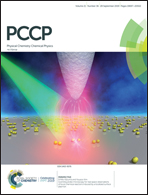The chalcogen bond: can it be formed by oxygen?†
Abstract
Several recent studies have shown that chalcogen bonds originate from the σ-holes localized on the electron-deficient surface of the Group 16 atoms (sulfur, selenium and tellurium) in molecules; however, the oxygen atom in molecules does not appear to form such a bond. In this study, we have considered oxygen difluoride (OF2) as a prototypical Lewis acid, and 11 Lewis bases as partner interacting species (CH3F, CH3Cl, CH3Br, H2CO, HFCO, HF, SO, CH3CN, PN, HSCN and HCN). Their complexes are examined using DFT-M06-2X and ab initio first-principles calculations at the MP2 level of theory, in conjunction with Dunning's all-electron correlated basis set aug-cc-pVTZ. The results that emerge from the equilibrium geometries, molecular electrostatic surface potential, second order natural bond orbital, quantum theory of atoms in molecules, reduced density gradient and independent gradient model noncovalent analyses tools, as well as from binding energy calculations, demonstrate that oxygen is indeed capable of forming a chalcogen bond. We show that the σ-holes on O along the F–O bond extensions in OF2 are positive, and can readily participate in chalcogen bonding (and other secondary interactions) with Lewis bases, thus providing stability to the geometries of all the 12 binary complexes examined. Finally, we demonstrate that without invoking charge density topologies the often used electrostatic surface potential model is certainly inadequate for the exploration of the noncovalent topology of bonding interactions in the majority of the dimers examined.



 Please wait while we load your content...
Please wait while we load your content...